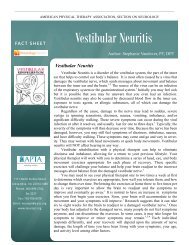Practice Guidelines for BPPV - Neurology Section
Practice Guidelines for BPPV - Neurology Section
Practice Guidelines for BPPV - Neurology Section
You also want an ePaper? Increase the reach of your titles
YUMPU automatically turns print PDFs into web optimized ePapers that Google loves.
Vestibular SIG Newsletter <strong>BPPV</strong> Special Edition<br />
Stop the world, I want to get off<br />
Vestibular Neurophysiology of Horizontal Semicircular Canal <strong>BPPV</strong><br />
Michael C Schubert, PT, PhD<br />
Johns Hopkins Medicine<br />
Benign Paroxysmal Positional Vertigo (<strong>BPPV</strong>) affecting the<br />
horizontal semicircular canal (hSCC) is not as uncommon as<br />
earlier estimates. Larger sample size studies (n>200)<br />
investigating the incidence of horizontal canal <strong>BPPV</strong> – verified<br />
from nystagmus recording or observation, confirm <strong>BPPV</strong> affects<br />
the hSCC from 10 to 31% (De la Meillieure et al 1996;<br />
Prokopakis et al 2005; Moon et al 2006).<br />
FUNDAMENTAL FACT:<br />
In hSCC <strong>BPPV</strong>, the nystagmus is always more<br />
intense when it is beating toward the affected ear<br />
(regardless of geotropic or apogeotropic).<br />
The challenge in diagnosing hc<strong>BPPV</strong> is determining the<br />
affected ear. Various clinical tests exist to test the HC <strong>for</strong><br />
<strong>BPPV</strong>, though that is not the intent of this article. Instead, we<br />
will focus on the anatomy and physiology explaining the<br />
nystagmus patterns associated with hSCC-<strong>BPPV</strong> and how to<br />
use that to determine the affected side. As is the case <strong>for</strong> the<br />
vertical semicircular canals, two types of <strong>BPPV</strong> afflict the<br />
hSCC; canalithiasis and cupulolithiasis. The predominate<br />
feature distinguishing these unique <strong>for</strong>ms is the duration of<br />
the nystagmus. Critical too is the direction of the nystagmus,<br />
though direction alone can mislead the clinician. Geotropic<br />
hSCC-<strong>BPPV</strong> is characterized by nystagmus beating towards the<br />
ear that is closest to earth when the head/body is positioned<br />
in side lying (McClure 1983; Baloh et al 1993). This is believed<br />
to be caused by free floating otoconia inside the endolymph<br />
of the HC and is termed canalithiasis (Baloh et al 1993;<br />
Lempert 1994). Apogeotropic (ageotropic) HC <strong>BPPV</strong> is<br />
characterized by nystagmus that beats away from the ear<br />
closest to earth when the head/body is positioned in side<br />
lying (Baloh et al 1995; Casani et al 1997: Fife TD 1998). This<br />
nystagmus pattern can be caused by otoconia attached to the<br />
cupula (cupulolithiasis) or from otolithic debris freely floating<br />
but located in the anterior arm of the HC near the cupula (in<br />
which case it would be labeled as canalithiasis) (Nuti 1998).<br />
Critical to understanding the physiology behind the<br />
nystagmus is to know the work of 37 year old Dr J—<br />
5<br />
this would be Dr Julius Richard Ewald. Dr Ewald was a<br />
German physiologist at the University of Strasbourg<br />
best known <strong>for</strong> his research on the flow of endolymph<br />
within the pigeon’s semicircular canals and related<br />
effect on the eyes (Ewald 1892). He is credited with<br />
establishing the important excitation-inhibition<br />
asymmetry, which states an ampullopetal endolymph<br />
movement causes a greater stimulation than an<br />
ampullofugal one (Ewald’s 2 nd law). Recall that<br />
vestibular afferents from each semicircular canal can<br />
be inhibited or excited depending on the flow of<br />
endolymph. The ampulla of each SCC is the bulbar<br />
ending of the SCC adjacent to the utricle; it houses<br />
the sensory epithelial cells and cupula. For ease, the<br />
word ampullo can be substituted with utriculo to give<br />
a clearer reference point <strong>for</strong> the flow of endolymph.<br />
Utriculopetal (ampulopetal) flow is towards the<br />
utricle (cupula) and there<strong>for</strong>e excitatory <strong>for</strong> the<br />
horizontal SCC. Utriculofugal (ampulofugal) flow is<br />
away from the utricle (cupula) and there<strong>for</strong>e<br />
inhibitory <strong>for</strong> the same horizontal SCC. 1 This means<br />
that head rotation in the excitatory direction of a<br />
canal elicits a greater response (afferent firing<br />
rate is higher) than does the same rotation in the<br />
inhibitory direction (Figure 1).<br />
1<br />
The opposite is true <strong>for</strong> the vertical semicircular<br />
canals (Ewalds 3rd law).<br />
Figure 1. Left vestibular afferent sensitivity to head<br />
rotation<br />
The resting firing rate of the mammalian vestibular afferents is<br />
~ 90 spikes/sec. Their sensitivity to head rotation is ~ 0.5<br />
spikes/deg/sec (Goldberg and Fernandez 1971; Lysakowski et<br />
al 1995). The resting firing rate enables each vestibular system<br />
to detect head rotation in either direction,with preference <strong>for</strong><br />
rotations on the side of the afferent. In this figure, the range of<br />
sensitivity <strong>for</strong> the left vestibular afferents <strong>for</strong> leftward (positive)<br />
rotations is greater than rotations to the right, because of the<br />
inhibition-excitation asymmetry.<br />
(Continued on page 16)

















